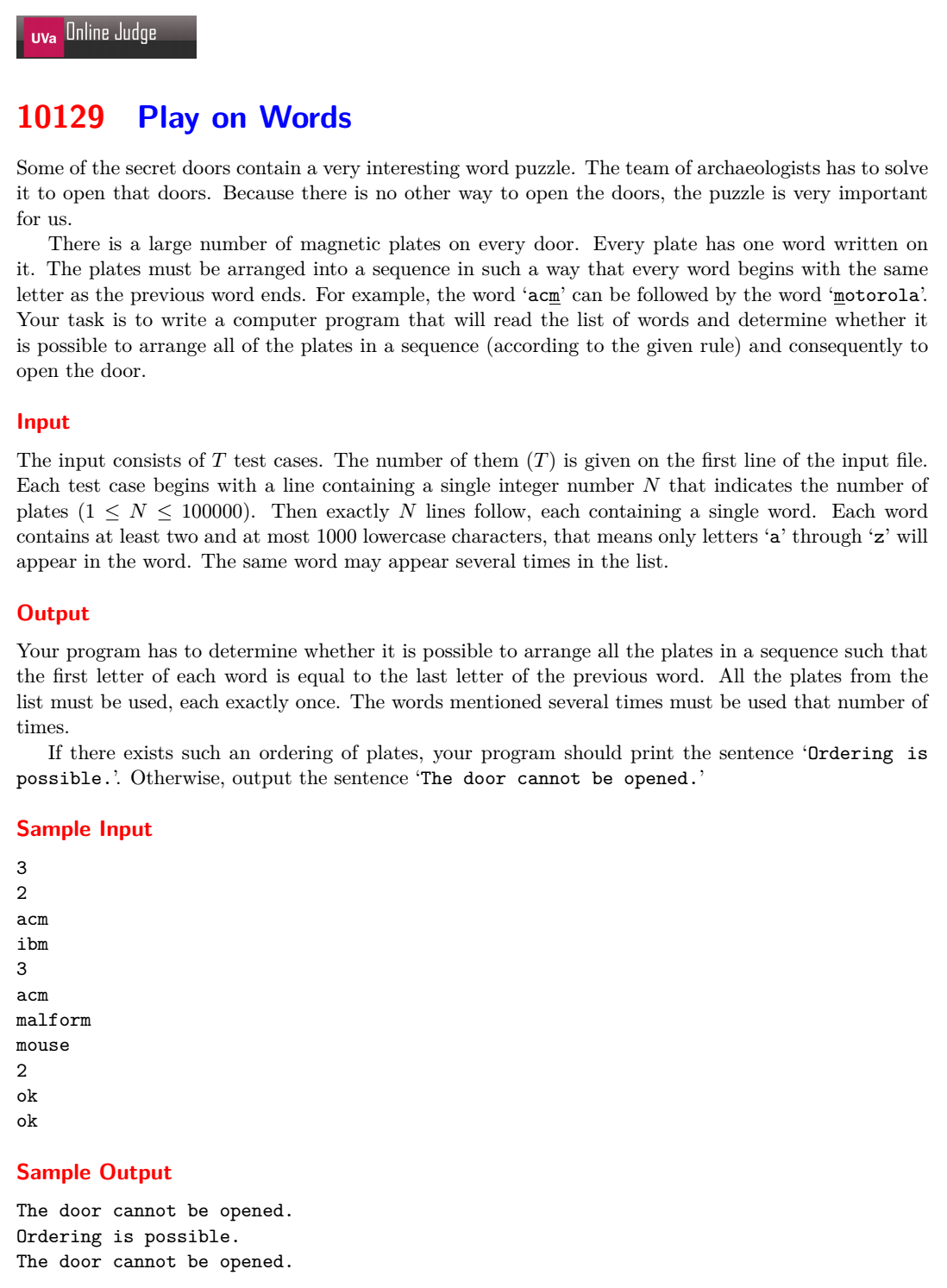【分析】
首先需对欧拉道路有所了解。
存在欧拉道路的充分条件:
对于无向图而言,如果一个无向图是连通的,且最多只有两个奇点(顶点的度数为奇数),则一定存在欧拉道路。如果有两个奇点,则必须从其中的一个奇点出发,另一个奇点终止;如果奇点不存在,则可以从任意点出发,最终一定会回到该点(称为欧拉回路)。
对于有向图而言,最多只能有两个点的入度不等于出度,而且必须是其中一个点的出度恰好比入度大1(把它作为起点),另一个的入度比出度大1(把它作为终点)。当然,还有一个前提条件:在忽略边的方向后,图必须是连通的。
对于该题而言,把字母看作结点,单词看成有向边,则问题有解,当且仅当图中有欧拉路径。有向图存在欧拉道路的条件有两个:底图(忽略边方向后得到的无向图)连通,且度数满足上面讨论过的条件。这里判断图连通的方法采用DFS。
用java语言编写程序,代码如下:
import java.io.BufferedInputStream;
import java.util.ArrayList;
import java.util.Scanner;
public class Main {
public static void main(String[] args) {
Scanner input = new Scanner(new BufferedInputStream(System.in));
int t = input.nextInt();
for(int i = 0; i < t; i++) {
int n = input.nextInt();
int[][] udg = new int[26][26];//无向图(用于判断图是否连通)
int[][] dg = new int[26][26];//有向图(判断顶点的度数是否符合欧拉道路的条件)
boolean[] isVisited = new boolean[26];//标记顶点是否已被访问过
//这里先赋值为true的原因是为了知道哪些顶点是图中所具有的。录入图的信息中,再将其顶点对应的isVisited值赋值为false
for(int j = 0; j < 26; j++)
isVisited[j] = true;
for(int j = 0; j < n; j++) {
String word = input.next();//边
int first = word.charAt(0) - 'a';//边的起点
int last = word.charAt(word.length() - 1) - 'a';//边的终点
udg[first][last] = udg[last][first] = 1;//无向边
dg[first][last]++;//有向边(统计边的条数,用于计算各顶点的入度与出度)
isVisited[first] = isVisited[last] = false;
}
/*for(int j = 0; j < 26; j++)
System.out.println((char)('a' + j) + " : " + isVisited[j]);*/
boolean b1 = isConnected(udg, isVisited);//判断图是否具有连通性
boolean b2 = rightDegree(dg);//判断图中的顶点度数是否符合欧拉道路的充分条件
//System.out.println(b1 + "...." + b2);
if(b1 && b2)
System.out.println("Ordering is possible.");
else
System.out.println("The door cannot be opened.");
}
}
//采用DFS判断图是否具有连通性,如果图具有连通性的话,那么DFS只进行一次,否则DFS会进行多次
public static boolean isConnected(int[][] udg, boolean[] isVisited) {
int times = 0;
for(int i = 0; i < 26; i++) {
if(!isVisited[i]) {
//System.out.println((char)('a' + i));
times++;
dfs(i, udg, isVisited);
}
}
if(times > 1)
return false;
return true;
}
public static void dfs(int u, int[][] udg, boolean[] isVisited) {
if(u < 0 || u >= 26 || isVisited[u])
return;
isVisited[u] = true;
for(int v = 0; v < 26; v++)
if(!isVisited[v] && udg[u][v] > 0)
dfs(v, udg, isVisited);
}
public static boolean rightDegree(int[][] dg) {
Vertex[] vd = new Vertex[26];
//统计各顶点的入度与出度
for(int u = 0; u < 26; u++) {
for(int v = 0; v < 26; v++) {
if(dg[u][v] > 0) {
if(vd[u] == null)
vd[u] = new Vertex();
if(vd[v] == null)
vd[v] = new Vertex();
vd[u].outDegree += dg[u][v];
vd[v].inDegree += dg[u][v];
}
}
}
/*for(int i = 0; i < 26; i++)
if(vd[i] != null)
System.out.println((char)('a' + i) + " : "
+ vd[i].outDegree + " " + vd[i].inDegree);*/
//将出度与入度不同的顶点加入到链表中
ArrayList<Vertex> vdList = new ArrayList<Vertex>();
for(int i = 0; i < 26; i++) {
if(vd[i] != null && (vd[i].inDegree != vd[i].outDegree))
vdList.add(vd[i]);
}
if(vdList.size() < 2)
return true;
else if(vdList.size() == 2) {
Vertex v1 = vdList.get(0);
Vertex v2 = vdList.get(1);
if(((v1.inDegree - v1.outDegree == 1) && (v2.outDegree - v2.inDegree == 1))
|| ((v1.outDegree - v1.inDegree == 1) && (v2.inDegree - v2.outDegree == 1)))
return true;
}
return false;
}
static class Vertex {
int v;
int outDegree;
int inDegree;
}
}























 136
136











 被折叠的 条评论
为什么被折叠?
被折叠的 条评论
为什么被折叠?








